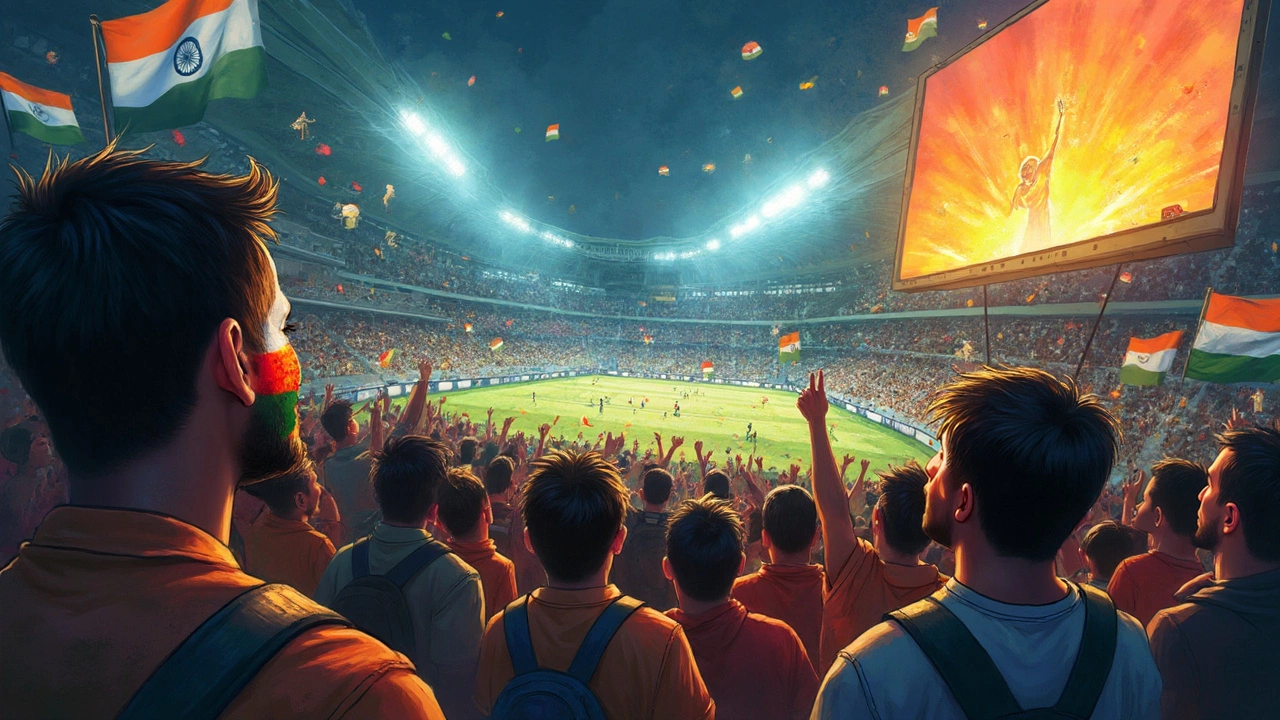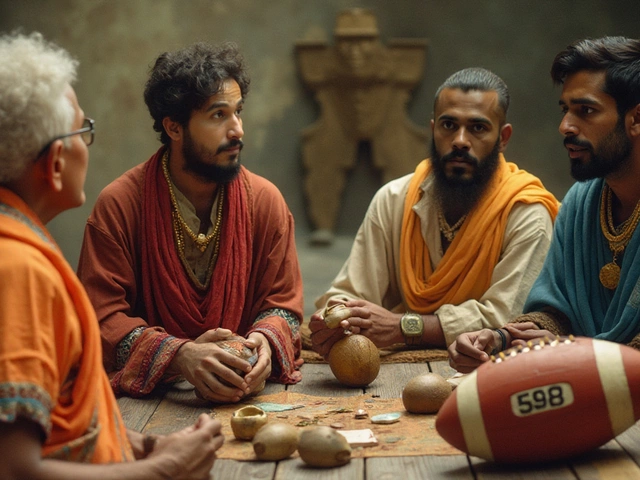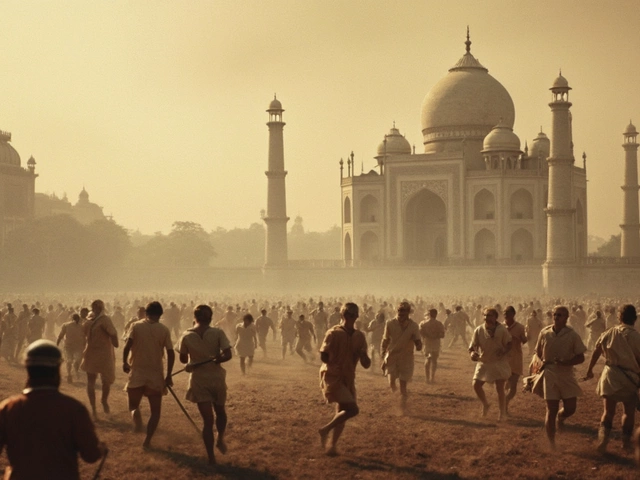If you’ve ever watched a football match, you know how contagious the excitement gets. Even people who don’t watch regularly suddenly care when there’s a big game. My son Tejas couldn’t tell you the offside rule last month, but thanks to the viral buzz of the Champions League finale, now he’s organizing matches in our apartment complex.
The craziest thing? You don’t need fancy gear or years of coaching. Kids in towns and villages make goals out of bricks or shoes—sometimes the ball is just a bundle of rags. Football’s simplicity means anybody can join in, anywhere. You only need a ball and a bit of open space. There’s no barrier—age, money, or language don’t matter.
Ask around, and you’ll spot a juicy fact: more than 3.5 billion people watched at least part of the 2022 World Cup final. That’s nearly half the planet tuning in! When a game can pause whole cities or light up entire families’ WhatsApp chats, there’s clearly something special going on.
- It’s Easy to Understand and Play
- Shared Emotions, Massive Crowds
- No Wallet Required
- Endless Stories and Drama
- Tips For Getting More from Football
It’s Easy to Understand and Play
The first thing that draws people in is how straightforward the game is. You kick the ball, try to get it in the net, and don’t use your hands unless you’re the goalie. The main rule? Get the ball into the other team’s goal more times than they get it into yours. That’s it. The simplicity knocks down barriers—no head-scratching over complicated rules, just jump in and play.
Football can be played just about anywhere. I’ve seen games in empty parking lots, tiny village playgrounds, and even narrow alleys. All you need is a half-decent ball and something for goalposts—could be a pair of backpacks or even old bottles. People love that you can dive in with friends or even strangers. The world’s most famous stadiums—like the Maracanã in Brazil or Wembley in London—all started somewhere small too.
Here’s a cool stat: FIFA claims there are over 265 million players worldwide, from amateur kids to pros, and more than 5 million officials running matches. That means around 4% of the world’s population is kicking a ball right now!
- Only 11 players per team needed for a full game—but street matches might have just 3 or 4 kids a side.
- Matches are short (90 minutes) but can be split into halves or even quick-fire 10-minute games.
- No complex equipment—just a ball and some open space.
Take a look at how simple the basics are compared to other big sports:
| Sport | Minimum Equipment | Players Needed | Ease of Learning |
|---|---|---|---|
| Football | Ball, goal markers | 2+ | High |
| Cricket | Bat, ball, stumps | Usually 11/side | Medium |
| Basketball | Ball, hoop | Usually 5/side | Medium |
| Baseball | Bat, ball, glove | Usually 9/side | Low-Medium |
So, if you’re looking for a game that’s easy to jump into—where the rules are clear and you don’t need much to start—football is hard to beat. That’s a big reason why it’s known as the football craze sweeping every corner of the globe.
Shared Emotions, Massive Crowds
Sit in a packed stadium during a big football match, and you’ll feel energy in the air—fans singing, flags waving, everyone buzzing with hope or nerves. Football brings millions together, all rooting for something bigger than themselves. It’s not rare for families to pass love for a team down the generations, making match day feel like a family event.
The numbers are wild. Some of the world’s highest attendance records aren’t concerts—they’re football games. The Maracanã Stadium in Brazil once hosted nearly 200,000 people for the 1950 World Cup final. Even today, stadiums in Europe and South America routinely pack in more than 80,000 fans. Check out some eye-popping attendance figures:
| Match/Event | Location | Attendance | Year |
|---|---|---|---|
| World Cup Final | Maracanã, Brazil | ~199,854 | 1950 |
| Champions League Final | Wembley, London | ~89,874 | 2013 |
| El Clásico | Camp Nou, Barcelona | ~99,264 | 2017 |
It goes beyond stadiums, though. Over 700 million people watched the 2018 World Cup final live on TV. Whatsapp and Instagram blow up during these games—memes, instant reactions, jokes, outrage—it’s like a worldwide living room. During big tournaments, my own family group chat becomes a mix of cheers, memes, and mock-arguments, all happening in real time.
If you ever get the chance to attend a match or even just join a group screening at a local café, you’ll understand why football is often called the world’s game. The shared highs and lows glue people together, sparking friendships and sometimes even lifelong rivalries. There’s no need to explain the rules—just show up, shout along, and join the crowd.

No Wallet Required
One of the reasons football rules the sports world is because you don’t need deep pockets to get involved. Seriously, you don’t have to spend a fortune on gear, training, or even tickets to enjoy the game. In so many places, football is played in narrow alleys, dusty fields, or even school corridors. The goalposts? Many times, it’s just a couple of schoolbags, bricks, or water bottles.
According to FIFA, nearly 265 million people actively play football across over 200 countries—most of them without access to fancy stadiums or pro equipment. The basic costs are so low, it doesn’t matter if you come from a bustling city or a rural village—you can always make it work.
"For millions of kids worldwide, all you need is a ball—doesn’t matter where it comes from. Football gives everyone a way in," says Arsène Wenger, legendary former Arsenal manager and FIFA’s Chief of Global Football Development.
To see how affordable football is compared to other sports, check out this simple breakdown:
| Sport | Average Equipment Cost (USD) | Typical Space Needed |
|---|---|---|
| Football | $10 (basic ball) | Any open area |
| Cricket | $40 (bat, ball, stumps) | Open field |
| Basketball | $30 (ball) | Court, hoop needed |
| Tennis | $60 (racket, balls) | Court required |
You’ll notice football comes out on top for being budget-friendly and super flexible. No wonder you see it played everywhere—from South American favelas to African villages, and even urban rooftops in Asia.
If you want to join in, here are a few tips:
- Don’t stress about buying a branded ball—anything round does the job.
- Form a team with whoever’s around: friends, siblings, neighbors, even your dad if he’s up for it!
- Use whatever space you can find—a building driveway, small park, backyard—just ask for permission if it’s not yours.
So, you don’t need big money to play or enjoy football. That’s probably why so many people feel connected to it. The action is for everyone, and that’s hard to beat.
Endless Stories and Drama
Football is honestly a goldmine for stories that stick in your mind. There’s always some wild underdog victory or heart-wrenching miss. Matches spin into full-blown sagas, with heroes, villains, comebacks, and feuds—all right there on the pitch. Even people who don’t follow the sport recognize stories like Leicester City’s shock win in 2016, when the odds for them to take the Premier League title were 5000 to 1. Imagine betting a hundred bucks on them and ending up with five hundred grand!
When you watch a big tournament, you’re not just looking at players chasing a ball. You’re seeing real moments that change careers and lives. Remember Zinedine Zidane’s infamous headbutt in the 2006 World Cup final? Or Andres Iniesta scoring the only goal in extra time for Spain in 2010, winning their first ever World Cup? These moments instantly become a part of football history, replayed for years.
Drama grabs people who’d usually skip a match. A last-minute goal, a penalty shoot-out, or a clear underdog knocking out a giant is pure adrenaline. The Champions League alone has delivered insane comebacks: Liverpool’s legendary turnaround versus Barcelona in 2019, when they clawed back from a 3–0 deficit. Stuff like this gets everyone talking, even those who don’t care much for football week-to-week.
The numbers speak for themselves. Here’s a quick peek at some of the most-watched, memorable moments:
| Event | Year | Estimated Viewers | Main Drama |
|---|---|---|---|
| World Cup Final: Argentina vs. France | 2022 | 1.5 billion+ | 3-3 draw, Messi vs. Mbappé, Argentina win on penalties |
| Champions League: Liverpool vs. Barcelona | 2019 | 100 million+ | 4-0 comeback win by Liverpool |
| World Cup Final: Italy vs. France | 2006 | 715 million | Zidane’s red card headbutt |
| Leicester City wins Premier League | 2016 | Global headlines | 5000-1 odds miracle run |
What makes it even better is that you can discuss these stories anywhere—in barber shops, family lunches, or just standing in line. There’s always fresh drama brewing, making every week unpredictable and fueling wild debates at work or school. It's no wonder football is the sport people can't stop talking about.

Tips For Getting More from Football
Want to squeeze every bit of fun and meaning from football? Here are some hands-on tips I’ve picked up—both from watching pros and running around fields with my son Tejas.
- Try different roles on the pitch. Don’t stick to one position. Even if you’re not the world’s best forward, try playing midfield or defense. Understanding more about different roles really deepens your appreciation when you’re watching games—or when you’re talking tactics with friends.
- Watch games with a crowd. The feeling you get from a stadium or even a packed living room is special. A Nielsen report found fans rate matches nearly twice as enjoyable in groups compared to watching alone. Plus, group viewing leads to better memories and more fun conversations.
- Follow both local and global clubs. It’s fun to root for your local heroes—there’s something about chanting for a team that plays down the road. But don’t ignore the big ones! Following clubs like FC Barcelona, Real Madrid, or Manchester United offers up wild drama and global culture all in one package.
- Learn a few basic rules if you’re new. Things like offside, yellow cards, or how extra time works are easy to pick up and make any match way less confusing. Tons of short YouTube videos explain the basics in minutes.
- Play, even if you’re not good. Nobody cares if you’re not Messi. Gather friends, a playground, or even your living room and kick a soft ball around. Regular playing saves you from sitting too long, and you’ll start noticing tricks when watching pros.
- Keep a game journal. This sounds nerdy, but jotting down awesome moments or wild goals you’ve seen—a scissor-kick by Ronaldo, a crazy save, or even Tejas’s winning goal in the rain—builds your own football story over time.
Most important: stay curious and open-minded. Talk to fans from other countries. Share stories. That’s how football becomes much more than just a game—it turns into a connection with people everywhere.




